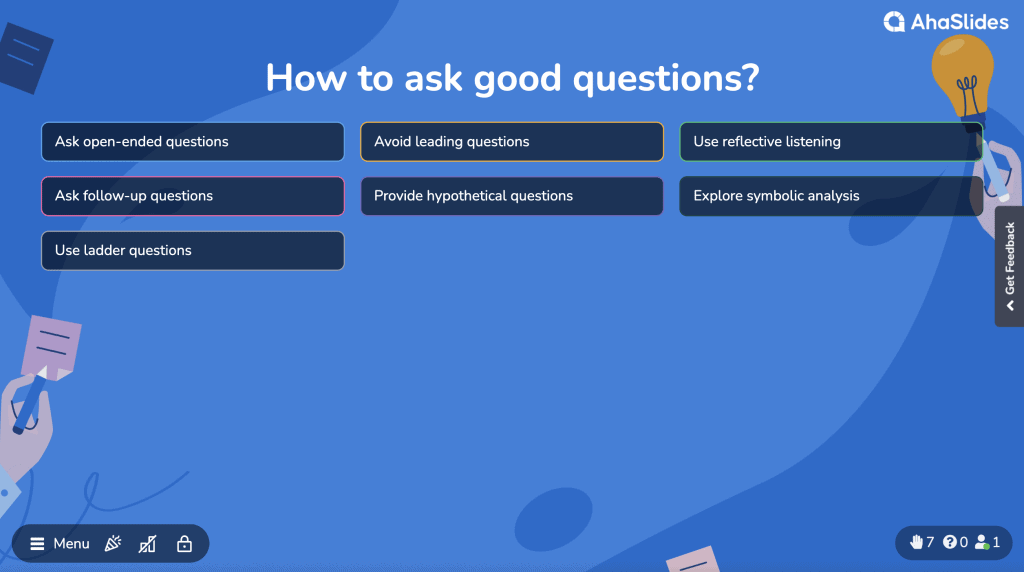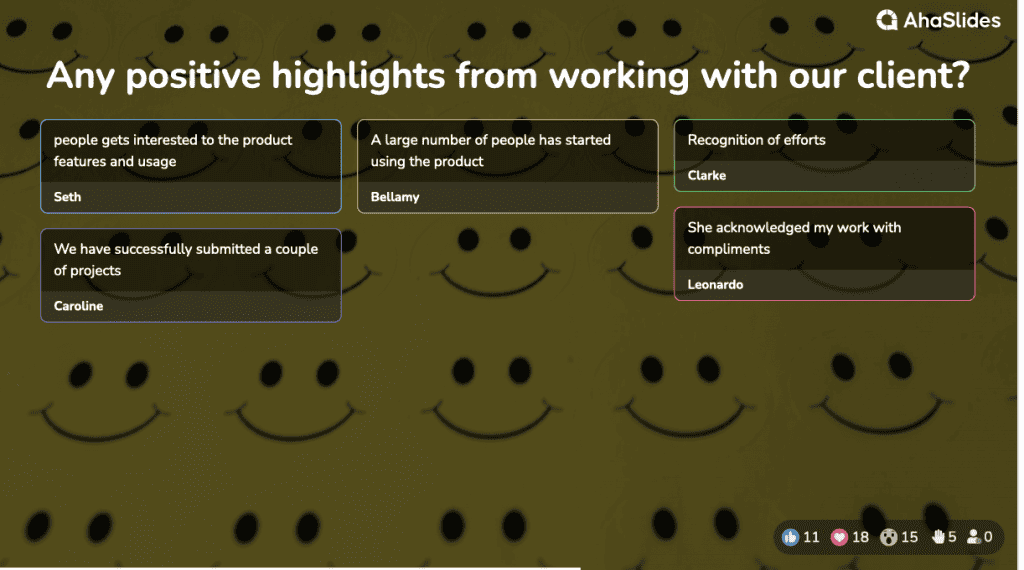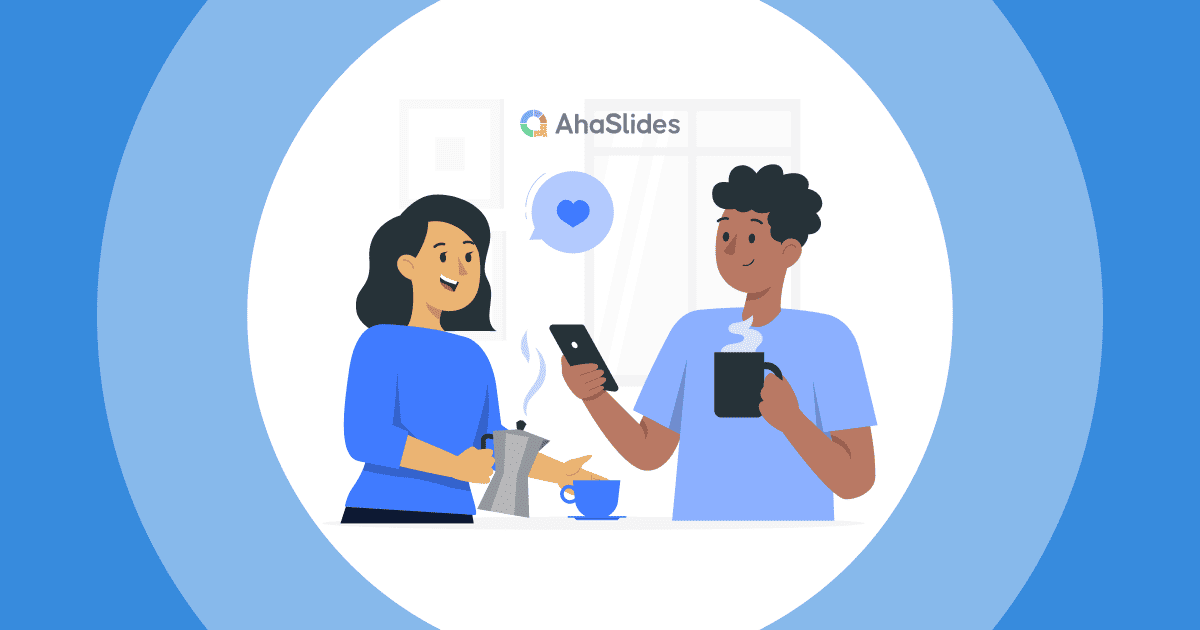궁금 질문하는 방법 제대로? 좋은 질문을 하려면 생각보다 더 많은 노력이 필요합니다.
솔직히, 낯선 사람과 대화를 시작하는 건 쉽지 않을 수 있습니다. 파티에 온 제니처럼, 우리 중 많은 사람들이 적절한 질문을 찾는 데 어려움을 겪습니다. 이는 사회적 환경뿐만 아니라 대화를 시작하는 것이 중요한 삶의 다양한 측면에도 적용됩니다.
오늘날 많은 사람들이 효과적인 질문을 하는 방법을 잘 모릅니다. 면접 결과를 확인하든, 누군가의 안부를 묻든, 아니면 단순히 대화를 시작하든, 질문을 던지는 능력은 중요합니다.
이 글에서는 질문의 힘, 좋은 질문자를 만드는 방법에 대해 자세히 알아보고, 질문 기술을 향상시키기 위한 실용적인 전략을 탐구합니다.

차례
- 좋은 질문은 무엇입니까?
- 질문을 잘하는 사람은 누구입니까?
- 성공적인 전략을 통해 특정 시나리오에서 질문하는 방법
- 7가지 효과적인 질문 기법
- 효과적으로 질문하는 방법: 7가지 최고의 팁
- 주요 요점
- 자주 묻는 질문들 (FAQ)
더 나은 참여를 위한 팁
- 라이브 Q & A 프레젠테이션에 힘을 실어주는 도구
- Q & A 세션
- 답장 어떻게 하세요

당신의 동료를 더 잘 알아보세요!
AhaSlides의 퀴즈와 게임을 사용하여 재미있고 대화형 설문 조사를 만들고 직장, 수업 또는 소규모 모임에서 대중의 의견을 수집하세요.
🚀 무료 설문조사 만들기☁️
좋은 질문은 무엇입니까?
훌륭한 질문을 하는 것은 훌륭한 답변을 찾는 것에서 시작한다고 생각할 수 있습니다. 하지만 무엇보다 먼저, 명확하고 간결한 질문 필수입니다. 질문 자체는 바로 요점을 짚는 것부터 시작해야 상대방이 혼란스러워하지 않고 무슨 말인지 정확히 이해할 수 있습니다.
둘째, 좋은 질문은 관련이 있습니다. 질문은 논의되는 주제와 관련이 있어야 합니다. 관련 없는 질문은 대화나 발표를 방해하고 모두의 시간을 낭비하게 할 수 있습니다. 따라서 질문이 해당 주제와 관련이 있는지 확인하는 것이 중요합니다.
셋째, 좋은 질문은 개방형이다토론을 장려하고 다양한 답변을 허용해야 합니다. "예" 또는 "아니요"로 간단히 답할 수 있는 폐쇄형 질문은 대화를 방해하고 얻는 정보를 제한할 수 있습니다. 반면, 개방형 질문은 사람들이 자신의 의견과 아이디어를 공유하도록 유도하여 더욱 깊고 생산적인 토론으로 이어집니다.
마지막으로, 좋은 질문은 흥미롭고 고무적인 호기심을 통해 청중. 이러한 질문은 사람들이 토론에 적극적으로 참여하고 고유한 통찰력과 아이디어를 공유하도록 권장되는 긍정적이고 자극적인 환경을 만드는 힘이 있습니다. 관심을 끄는 질문을 함으로써 보다 생산적이고 협력적인 대화를 촉진하여 당면한 주제를 더 깊이 이해할 수 있습니다.
질문을 잘하는 사람은 누구입니까?
어떤 사람들에게는 질문이 쉽게 오지만 다른 사람들에게는 도전적입니다. 어떤 사람들은 질문을 잘하는 반면 다른 사람들은 질문하는 데 어려움을 겪는 이유가 궁금한 적이 있습니까? 훌륭한 질문을 던질 수 있는 능력은 모든 사람이 가지고 있지 않은 귀중한 기술이라는 것이 밝혀졌습니다.
예를 들어, 심리학자와 같은 전문가는 고객이 자신과 자신의 삶에 대해 더 깊이 생각하도록 영감을 주는 생각을 자극하는 질문을 하는 능력으로 잘 알려져 있습니다. 그러나 그들이 그렇게 잘하는 이유는 무엇입니까?
이를 전략적 접근 방식으로 받아들이고 좋은 질문자를 정의하는 몇 가지 특성을 확인하세요.

적극적이고 공감적으로 경청하는 능력다른 사람들이 하는 말에 주의 깊게 귀를 기울이면 청중의 상황에 대한 이해를 명확히 하고 심화시키는 후속 질문을 할 수 있습니다.
탐색 질문을 할 수 있는 능력. 탐색 질문은 가정에 도전하고 질문을 받는 사람이 자신의 신념과 관점에 대해 비판적으로 생각하도록 장려하는 질문입니다. 좋은 질문자는 비판단적이고 지지적인 방식으로 탐구적인 질문을 하는 방법을 알고 있으며, 이는 성찰을 자극하고 개인 성장을 촉진하는 데 도움이 될 수 있습니다.
질문의 용기 더 깊은 통찰력, 이해, 그리고 긍정적인 변화로 이어집니다. 호기심과 열린 마음으로 안전지대를 벗어나 용기와 예민함, 그리고 질문받는 사람에 대한 존중 사이에서 균형을 맞춰야 합니다.
성공적인 전략을 통해 특정 시나리오에서 질문하는 방법
인생에서 질문하기 가장 어려운 순간은 언제인가요? 만약 다음과 같은 상황에 처해 있다면, 이를 영감의 원천으로 삼을 수 있습니다. 그렇지 않더라도 걱정하지 마세요. 질문하는 데 필요한 모든 기술은 다음 섹션에 있습니다.
질문하는 방법 – 누군가에게 대화를 요청하는 방법
누군가에게 대화를 요청하고 싶다면, 상대방의 시간과 경계를 존중하는 동시에 명확하고 직접적인 어조로 말하는 것이 중요합니다. 여러분의 상황에 적용할 수 있는 예시를 소개합니다.
- [특정 주제]에 대해 이야기 나눌 수 있으면 좋겠습니다. 혹시 곧 저와 이야기 나눌 수 있을까요?
- [특정 문제]에 대한 당신의 통찰력과 관점을 정말 감사하게 생각합니다. 시간 되시면 저와 이야기 나눠보실 수 있을까요?
질문하는 방법 – 피드백을 요청하는 방법
개인적, 직업적 성장의 중요한 부분으로 우리는 주변 사람들, 친구, 가족, 동료, 관리자에게 피드백을 요청하는 경우가 많습니다. 그리고 우리 모두는 정직하고 개방적인 답변을 원합니다. 다음은 질문의 예입니다.
- 친구나 가족에게서: "[이름]님, 안녕하세요. 당신의 의견을 소중히 여기고 제가 진행 중인 새 프로젝트에 대한 피드백을 주실 수 있을까요? 혹시 제가 다르게 또는 더 잘할 수 있는 부분이 있을까요?"
- 고객 또는 의뢰인으로부터: "[고객 이름]님, 저희는 항상 서비스 개선 방안을 모색하고 있으며, 최근 저희와 함께하신 경험에 대한 피드백을 듣고 싶습니다. 특별히 마음에 드셨거나 마음에 들지 않으셨던 부분이 있으신가요? 개선을 위한 제안이 있으신가요?"
관련:
질문하는 방법 – 비즈니스에서 올바른 질문을 하는 방법
비즈니스에서 올바른 질문과 현명한 질문을 하고 싶다면 정보에 입각한 결정을 내리고 성공적인 결과를 얻는 것이 중요합니다. 직장에서 질문하는 예는 다음과 같습니다.
- 비슷한 상황에 있는 다른 고객에게 이 솔루션이 어떻게 효과가 있었는지 예를 들어주실 수 있나요?
- 이 프로젝트의 성공을 측정하기 위해 어떤 지표를 사용합니까?
질문하는 방법 – 이메일을 통해 전문적으로 질문하는 방법
이메일로 전문적인 질문을 할 때는 명확하고 간결하며 예의를 갖추는 것이 중요합니다. 이메일을 통해 전문적인 질문을 하는 좋은 예는 다음과 같습니다.
- 설명 질문 방식: 보고서를 보내주셔서 감사합니다. [특정 섹션]에 대해 간단한 질문이 있습니다. [보고서의 특정 부분]을 명확히 설명해 주시겠습니까?
- 정보 질문: 이 이메일이 귀하를 잘 찾으셨기를 바랍니다. [주제]에 대한 추가 정보를 요청하기 위해 연락드립니다. 구체적으로 [구체적인 질문]이 궁금합니다. 이 문제에 대한 자세한 내용을 알려주시겠습니까?
질문하는 방법 – 누군가에게 멘토가 되어달라고 요청하는 방법
누군가에게 멘토가 되어 달라고 요청하는 것은 겁이 날 수 있지만 더 많은 경험을 가진 사람으로부터 배우고 성장할 수 있는 소중한 기회가 될 수도 있습니다. 다음은 누군가에게 멘토가 되어달라고 요청하는 방법의 예입니다.
- 직접 접근: "[멘토 이름]님, 안녕하세요. 멘토님의 작업에 깊은 인상을 받았습니다. 멘토님의 경험과 전문성을 통해 배우고 싶습니다. 제 멘토가 되어 주시겠습니까?"
- 지도 요청: "[멘토 이름]님, 안녕하세요. 저는 지금 경력이 깊어 경험이 더 많은 분께 조언을 구하고 싶습니다. 멘토님의 작업을 정말 존경하고 훌륭한 멘토가 되어 주실 수 있을 것 같습니다. 혹시 멘토링에 참여하실 생각이 있으신가요?"
질문하는 방법 – 상대방이 괜찮은지 아닌지 묻는 방법
누군가 걱정되어 안부를 묻고 싶다면, 세심하고 배려하는 마음으로 대화에 임하는 것이 중요합니다. 다음 예시들이 도움이 될 수 있습니다.
- 요즘 좀 조용하신 것 같아요. 혹시 나누고 싶은 이야기가 있으신가요?
- 힘든 시간을 보내신 것 같네요. 혹시 이야기 나눌 사람이 필요하거나 그냥 속마음을 털어놓고 싶으시면 제가 여기 있어요.
관련 :
질문하는 방법 – 면접 요청 방법
취업 면접을 요청하려면 재치 있고 전문적인 접근 방식이 필요하며 해당 직책에 대한 귀하의 열의와 능력을 보여줘야 합니다. 좋은 인상을 남기는 데 도움이 되는 창의적이고 효과적인 면접 요청 방법은 다음과 같습니다.
예 :
지난 주 [이벤트/네트워킹 미팅]에서 만나뵙게 되어 반가웠고 [산업/기업]에 대한 귀하의 통찰력에 깊은 인상을 받았습니다. 저는 [회사]에 대한 지속적인 관심을 표명하고 관련 공석에 대한 인터뷰를 요청하기 위해 편지를 씁니다.
저는 제 기술과 경험이 [회사]에 적합하다고 생각하며 제 자격에 대해 귀하와 더 자세히 논의할 수 있는 기회를 환영합니다. 저와 인터뷰 일정을 잡으실 의향이 있으시면 편리한 시간을 알려주십시오. 전화나 직접 대면 중 가장 편리한 방법으로 상담할 수 있습니다.
7 효과적인 질문 기법

원하는 것을 찾기 위해 다양한 질문 기법을 활용해야 하는 경우가 있습니다. 질문하는 방법을 아직 모르겠다면, 공식적이든 비공식적이든 활용할 수 있는 몇 가지 생산적인 질문 기법을 소개합니다.
# 1. 개방형 질문을 하세요: 개방형 질문은 상대방이 더 많은 정보를 공유하도록 유도하고 더 깊은 통찰력과 이해를 이끌어내는 데 도움이 될 수 있습니다. 이러한 질문은 종종 "무엇", "어떻게", 또는 "왜"로 시작합니다.
# 2. 유도 질문 피하기: 유도 질문은 답변에 편향을 초래하고 상대방이 자신의 생각과 감정을 솔직하게 표현하는 능력을 제한할 수 있습니다. 특정 답변을 암시하거나 특정 관점을 전제로 하는 질문은 피하세요.
# 3. 반영적 청취 사용: 성찰적 경청은 그 사람이 말한 내용을 반복하거나 바꾸어 표현하여 당신이 그들의 관점을 듣고 이해했음을 보여줍니다. 이는 신뢰를 구축하고 열린 커뮤니케이션을 위한 안전한 공간을 만드는 데 도움이 될 수 있습니다.
# 4. 후속 질문하기: 후속 질문은 정보를 명확히 하고, 주제를 더 깊이 있게 탐구하며, 대화에 적극적으로 참여하고 있음을 보여주는 데 도움이 될 수 있습니다. 이러한 질문은 종종 "…에 대해 더 자세히 말씀해 주시겠습니까?" 또는 "…라고 하셨는데, 무슨 뜻인가요?"로 시작합니다.
# 5. 가상의 질문: 이러한 유형의 질문은 응답자에게 가상의 상황을 상상하고 그 상황에 기반하여 답변을 제시하도록 요청합니다. 예를 들어, "만약 ~라면 어떻게 하시겠습니까?"와 같이 질문할 수 있습니다.
# 6. 기호 분석: 논리적인 반대말에 초점을 맞추고 무엇이 아닌지 알아보려는 질문입니다. "없이", "아님", "더 이상은 아님" 등의 질문을 사용하여 다양한 옵션과 시나리오를 탐색할 수 있습니다.
# 7. 사다리타기 이는 근본적인 신념과 가치를 탐구하는 강력한 도구가 될 수 있으며 다른 사람의 동기와 관점을 더 잘 이해하는 데 도움이 될 수 있습니다. 특히 마케팅 및 영업에 유용할 수 있습니다.
효과적으로 질문하는 방법: 7가지 최고의 팁
질문은 효과적인 의사소통과 지식 습득에 필수적인 요소입니다. 하지만 단순히 아무 질문이나 하는 것이 아니라, 적절한 시기에 적절한 방식으로 적절한 질문을 하는 것이 중요합니다. 그렇다면 다른 사람들에게 긍정적이고 오래 지속되는 인상을 남기는 질문은 어떻게 할 수 있을까요? 정중하게 질문하는 방법은 무엇일까요?
매력적이고 정직하며 개방적인 환경 조성: 효과적인 소통은 양방향으로 이루어집니다. AhaSlides' 개방형 플랫폼 사람들이 서로의 아이디어를 놓고 의견을 교환하고, 제출하고, 최고의 아이디어에 투표할 수 있는 떠들썩한 마음을 불러일으킬 것입니다.

목표 정의: 질문을 하기 전에 목표와 이를 달성하는 데 필요한 정보를 명확히 하십시오. 이렇게 하면 질문에 집중하고 관련 없는 주제에 시간을 낭비하지 않도록 할 수 있습니다.
가정을 피하십시오: 자신이 아는 것이나 상대방이 아는 것에 대해 추측하지 마세요. 대신, 상대방이 자신의 생각과 통찰력을 공유하도록 유도하는 개방형 질문을 하세요.
구체적으로: 명확하고 간결한 정보로 답변할 수 있는 구체적인 질문을 합니다. 모호하거나 지나치게 광범위한 질문은 혼란과 비생산적인 토론으로 이어질 수 있습니다.
적극적으로 경청: 적절한 질문을 하는 것은 문제의 절반일 뿐입니다. 상대방의 답변에 적극적으로 귀 기울여야 합니다. 말하는 사람의 어조, 바디 랭귀지, 그리고 답변의 뉘앙스에 주의를 기울여 그들의 관점을 더 깊이 이해하세요.
긍정적이고 건설적으로 질문의 틀을 잡으세요: 부정적인 언어나 비난하는 어조를 사용하지 마십시오. 이는 상대방을 방어적으로 만들고 생산적인 대화에 참여하지 못하게 할 수 있습니다.
집중하라: 당면한 주제에 집중하고 관련 없는 문제로 인해 곁길로 빠지지 않도록 합니다. 별도의 주제를 다루어야 하는 경우 별도의 대화를 예약하여 논의하십시오.
주요 요점
질문하는 방법에 대해 지금 당장 자신만의 답변과 결정을 내릴 수 있습니다. 다음에 질문을 시작해야 하는 상황에 처하게 되면 더 이상 어려움을 겪지 않을 수도 있다는 것은 완전히 확실합니다.
자주 묻는 질문들 (FAQ)
질문을 하는 좋은 방법은 무엇입니까?
한 번에 하나씩 질문하고 필요한 경우 맥락을 설명하세요. 배려하고, 참여하고, 이해하는 데 집중하는 것은 질문하는 방식을 보여줍니다.
10가지 질문은?
1. 당신은 재미로 무엇을 하는 것을 좋아합니까?
2. 가장 좋아하는 영화/TV 프로그램은 무엇입니까?
3. 최근에 배운 것은 무엇입니까?
4. 직업/학교에서 가장 좋아하는 점은 무엇입니까?
5. 어린 시절 가장 좋아하는 추억은 무엇입니까?
6. 당신의 꿈의 휴가지는 어디입니까?
7. 당신이 정말 잘하는 일은 무엇인가요?
8. 올해 꼭 이루고 싶은 일은 무엇인가요?
9. 가장 좋아하는 주말 활동은 무엇입니까?
10. 지금 당신의 삶에서 어떤 흥미로운 일이 일어나고 있나요?
현명한 질문은 어떻게 하시나요?
더 깊은 통찰력을 얻으려면 단순히 사실적인 답변이 아닌 '왜' 또는 '어떻게'라는 질문을 던지세요. "왜 그렇게 생각하셨나요?" "그 문제를 어떻게 해결하셨나요?" 화자의 의견이나 아이디어를 언급하여 적극적으로 경청하고 있음을 보여주세요. "X를 언급하셨을 때 Y라는 질문이 떠올랐습니다."
참고 : HBYR







